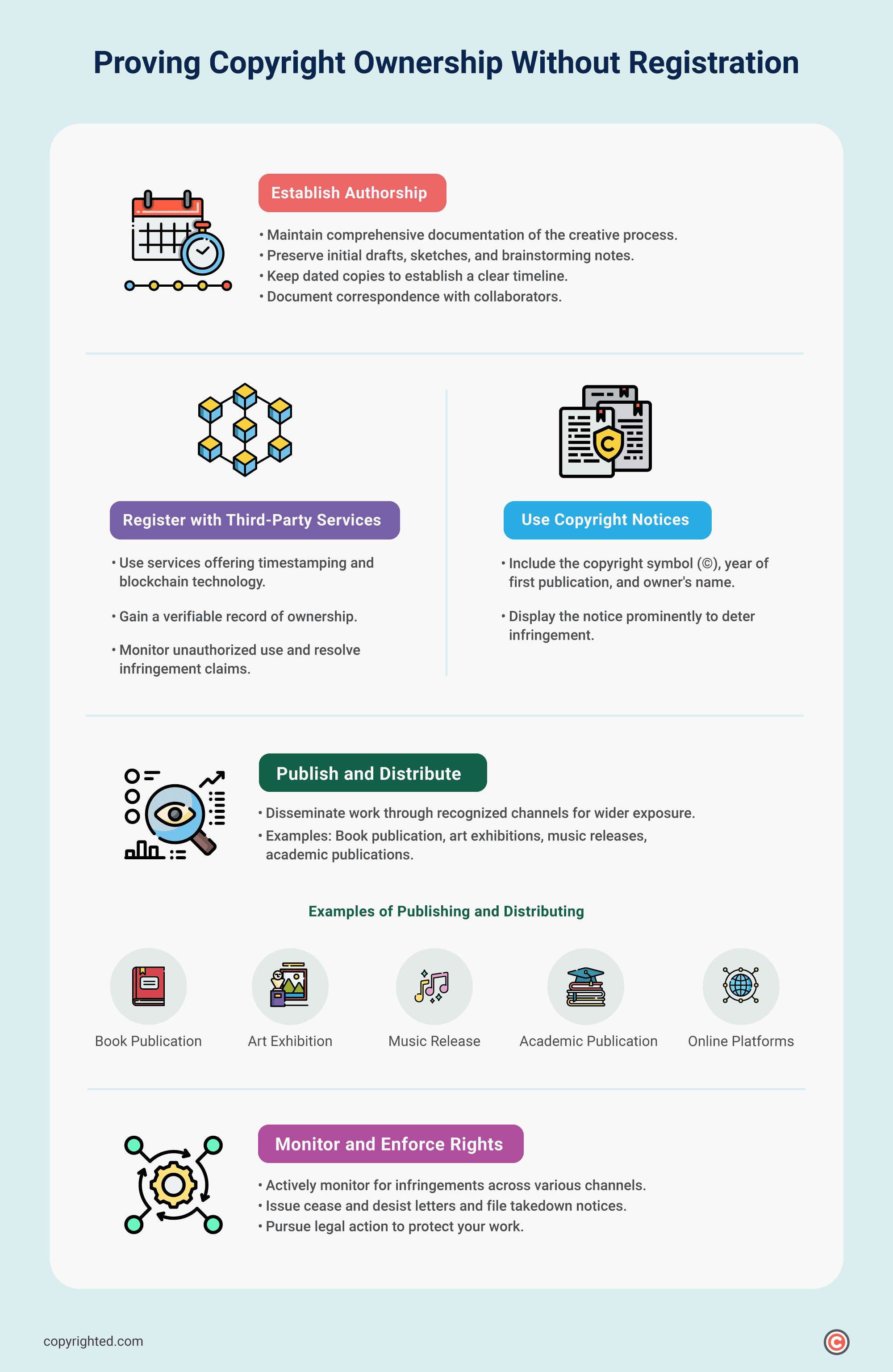Many believe copyright protection requires formal registration with the copyright office, but is this true?
In this post, we’ll debunk common misconceptions surrounding copyright ownership and explore how you can establish your exclusive rights as a creator. Whether you’re an aspiring writer, artist, musician, or content creator, understanding your rights is more important than ever in today’s digital landscape.
- The moment a work is created and fixed in a tangible form, it is automatically protected by copyright law.
- While formal registration with copyright offices provides strong evidence of ownership, it’s not the only means available.
- Including a copyright notice on your work serves as a clear indicator of your ownership and rights.
Table of Contents
Can You Claim Copyright Without Registering?
Yes, you can claim copyright without registering your work.
Copyright is a form of legal protection granted to the creators of original works of authorship. These works can include literary, artistic, musical, and other creative works.
The moment a work is created and fixed in a tangible form, such as writing it down, recording it, or saving it digitally, it is automatically protected by copyright law. This means that as soon as you write a story, compose a song, or create a piece of art, you are the copyright owner of that work.
But still, many creators wonder, do you need to register copyright to fully protect your rights and make enforcement easier? While registration is optional, it offers significant legal benefits if infringement occurs.
Now, while copyright protection is automatic, there are additional steps you can take to further establish and assert your rights as a copyright owner.
One such step is registering your copyright with the appropriate government authority, such as the U.S. Copyright Office in the United States.
Registration involves submitting an application, a fee, and a copy of the work to the copyright office. Once registered, the copyright owner receives a certificate of registration, which serves as official documentation of their copyright claim.
However, it’s important to note that registration is not a prerequisite for copyright protection. In other words, you don’t need to register your work to claim copyright ownership.
The moment your work is created and fixed in a tangible form, you hold the copyright to it. This principle is enshrined in international copyright treaties and laws, including the Berne Convention.
Even without copyright registration, you possess exclusive rights to your work, including reproduction, distribution, public performance or display, and the creation of derivative works. Essentially, you have the sole authority to decide how your work is used and who can use it.
How Do You Indicate Copyright Ownership Without Registering?
Now that we’ve established that copyright registration is not a condition for copyright protection let’s talk about practical ways to indicate copyright ownership without formal registration.
- Copyright Notice: You can include a copyright notice on your work to indicate your ownership. This typically consists of the copyright symbol (©), the year of first publication, and the name of the copyright owner. For example: © 2024 John Doe.
- Watermarks: You can add a visible watermark containing your name or copyright notice for digital works, such as images or documents. Watermarks clarify that the work is protected by copyright and who the owner is.
- Metadata: Embedding copyright information into the metadata of digital files can serve as a way to indicate ownership. Metadata can include the creator’s name, copyright status, and contact information.
- Website Terms of Use: If you’re publishing your work online, you can include copyright information in your website’s terms of use or copyright notice section. This can specify users’ rights to use your content and assert your ownership.
- Creative Commons Licenses: You can choose to license your work under a Creative Commons license, which allows others to use your work under certain conditions specified by you. While this doesn’t indicate traditional copyright ownership, it provides a framework for how others can use your work while respecting your rights.
- Documentation: Keep records of your creation process, including drafts, sketches, or notes, along with dates and any relevant correspondence. This documentation can serve as evidence of your ownership if disputes arise.
While these methods can help indicate your ownership of a work, they may not provide the same level of protection as formal registration with the copyright office. However, they can still be valuable tools in establishing your rights and deterring infringement.
How Do You Prove Copyright Ownership Without Registration?
While formal registration with copyright offices provides strong evidence of ownership, it’s not the only means available. In situations where copyright registration hasn’t been pursued or completed, you can still take proactive steps to establish your authorship and affirm your rights.

1. Establish Authorship
One effective method is to maintain comprehensive documentation of the creative process. This documentation may include initial drafts, sketches, brainstorming notes, and any other materials that showcase the evolution of the work from concept to completion.
By preserving dated copies of these materials, you can establish a timeline that supports your authorship claim. Additionally, keeping records of correspondence with collaborators, such as emails or meeting minutes, can provide further evidence of your involvement and contributions to the work.
These serve as valuable evidence in demonstrating the originality and creativity inherent in the work, thereby solidifying your ownership rights.
2. Use Copyright Notices
Employing copyright notices is a straightforward way to declare ownership and notify others of your rights. A copyright notice typically consists of the copyright symbol (©), the year of first publication, and the name of the copyright owner.
By prominently displaying this notice on the work itself, you can signal to the public that the work is protected by copyright and that unauthorized use may result in legal consequences.
Not only does a copyright notice serve as an obstacle to potential infringers, but it also provides valuable information for individuals seeking permission to use the work lawfully.
In cases of infringement, the presence of a copyright notice can strengthen your position by demonstrating that the infringer knew your rights.
3. Register with Third-Party Services
Registering the work with reputable third-party services or platforms that offer copyright protection and timestamping capabilities provides you with an additional layer of verification and documentation. These services create a digital record of the work’s existence and ownership, typically through timestamped certificates or blockchain technology.
By registering your work with such services, you can establish an independent, verifiable record of your copyright claim that can be used as evidence in legal proceedings or disputes.
Third-party registration services often offer added benefits such as monitoring for unauthorized use and facilitating the resolution of infringement claims, further safeguarding the creator’s rights and interests.
Another important aspect some creators consider is anonymous copyright registration, which allows them to protect their work while keeping their personal identity confidential. This option can be particularly valuable for artists, writers, or developers who prioritize privacy.
4. Publish and Distribute
Publishing and distributing the work through reputable channels exposes it to a wider audience and establishes a public record of ownership. You create a visible footprint that reinforces your copyright claim by disseminating the work through recognized platforms, professional associations, or publishing houses.
These channels often maintain records of publication dates and ownership, providing additional documentation of the creator’s rights. Furthermore, publishing the work in reputable venues can enhance its credibility and visibility, making it less susceptible to unauthorized use or misappropriation by third parties.
Here are some examples of publishing and distributing work through reputable channels:
- Book Publication: If you’re an author, publish your book through established publishing houses like Penguin Random House, HarperCollins, or Simon & Schuster, which provide a reputable platform for your work. These publishers have well-established distribution networks and maintain comprehensive publication dates, editions, and authorship records, reinforcing your copyright claim.
- Art Exhibition: For visual artists, showcasing your artwork in reputable galleries or museums can establish a public record of ownership. Galleries often maintain exhibition catalogs or documentation that include details about the artists and their works, serving as evidence of authorship and copyright ownership.
- Music Release: Musicians can distribute their music through recognized music labels or digital platforms such as Spotify, Apple Music, or Bandcamp. These platforms provide widespread exposure to your music and maintain detailed records of release dates, album credits, and copyright ownership, bolstering your claim to the music’s copyright.
- Academic Publication: Scholars and researchers can publish their academic papers or articles in reputable journals or academic presses.
- Online Platforms: Utilizing reputable online platforms such as Amazon Kindle Direct Publishing for books, Etsy for handmade crafts and artwork, or SoundCloud for music can also establish a public record of ownership.
5. Monitor and Enforce Rights
As a creator, you should actively monitor various channels, including online platforms, social media, and traditional media, to identify potential infringements promptly. You should take swift and decisive action to enforce your rights upon discovering unauthorized use.
This may involve issuing cease and desist letters, filing takedown notices with hosting providers or social media platforms, or pursuing legal action against infringers. By actively enforcing your rights, you send a clear message that unauthorized use will not be tolerated and demonstrate your commitment to protecting your creative works from exploitation or misuse.
Frequently Asked Questions
Should a copyright be registered?
Yes, registering your copyright is advisable. It provides legal benefits and establishes a public record of ownership, enhancing your ability to protect your work.
Do you have to register your work to be protected?
No, your work is protected automatically upon creation. However, registration strengthens protection and offers legal advantages in case of infringement.
Why should you register your copyright if it’s automatic?
Registering your copyright provides concrete evidence of ownership, which is important for enforcing your rights, especially in legal proceedings such as infringement lawsuits.
Is it recommended that you register your copyright even for unpublished works?
Yes, registering unpublished works establishes a public record of ownership and provides added protection against infringement.
Can you still sue for copyright infringement without registration?
In many jurisdictions, registration is necessary to file a lawsuit for copyright infringement. While protection is automatic, registration offers key legal advantages in enforcing your rights.


